Today I am sharing how we prepare the rice flour lamp, aka maa vilakku, for the festive days. Check out how to make maa vilakku with store-bought rice flour with detailed step-wise pictures.
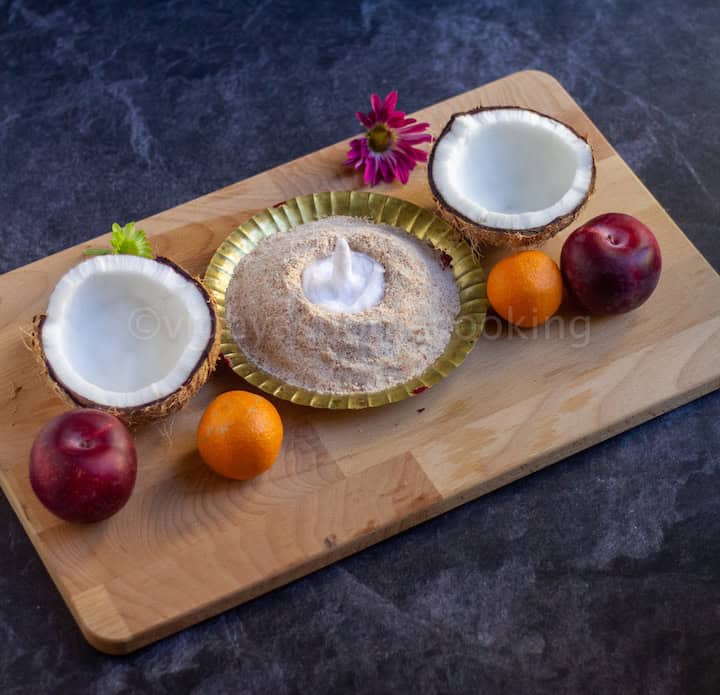
After posting back to back for a month, I took a small break, and now I am back with my new post. I believe it’s hard for me to stay away from blogging. If you are curious to know about all the thalis – check out this Thali round-up post. I am sure you will love it.
Ok, now back to maa vilakku. I will be sharing a couple of Navratri special recipes before getting into fall-special recipes.
Disclaimer – Every family has its way of preparing this rice flour lamp, and also the pooja rituals are different. I am sharing what we follow in our family.
What is maa vilakku?
Maa Vilakku is edible rice flour and jaggery lamp that we prepare on auspicious days as prasadam/offering in South India. Maa Vilakku is a Tamil word meaning flour lamp, and we use rice flour for making this lamp. In Kannada, we call it as Hittina Deepa, and in Telugu, it is Pindi deepam.
We mix the rice flour, jaggery along with ghee, and some condiments for this maa vilakku. While some make balls and create a dent to lit the lamp, in our family, we place the flour in a plate and press it tightly and make a small dent in the middle, as shown in this picture. We don’t make balls.
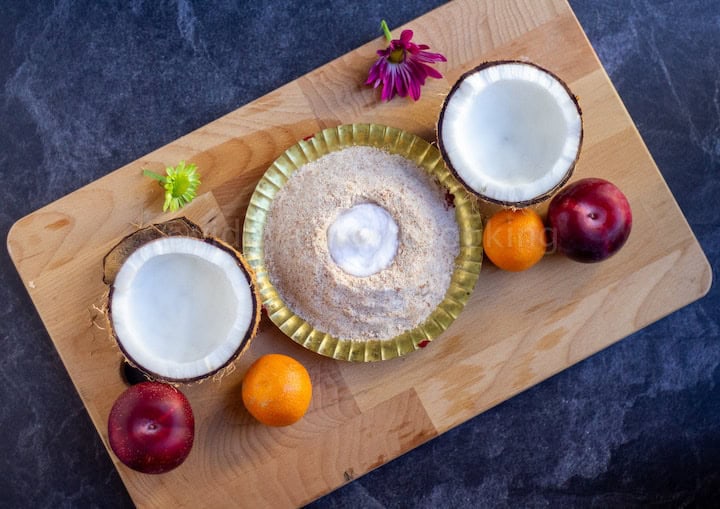
PS – It is more like akki tambittu but without any water/milk. We shape the akki tambittu like laddus, which is not the case for this one.
On what occasion we make maa vilakku?
Many prepare this maa vilakku in the month of ashada/aadi, especially on Fridays. We make this maa vilakku during the month of Bhadrapada or Puratasi, as we say in Tamil. Typically Navratri ( the 9-day festival) spans during this Bhadrapada month, and we usually pick a second Saturday or the Navratri Saturday and prepare this lamp and offer to our family deity.
Growing up in Periyakulam, maa vilakku is a regular fare during all the temple festivals. We used to make this lamp for the local Mariamman temple festival and also during Navratri Saturdays.
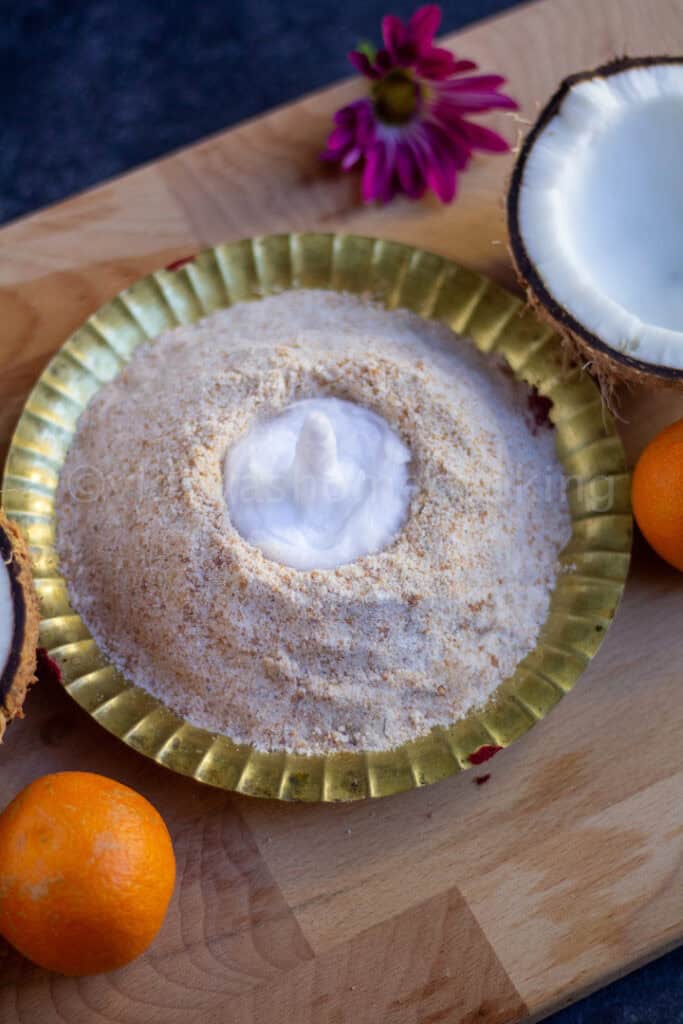
Why do we lit this lamp?
I don’t know the exact reason or significance behind this rice flour lamp. But as I mentioned in the Gowri Habba thali post, we follow and practice all these rituals – to seek the divine God’s blessings.
While researching this topic, I came across this FB page where they talk about the significance, and here is the link.
Now let me share how to make this maa vilakku or rice flour lamp with store-bought rice flour and the procedure right away. As I mentioned before, we don’t make lamp balls but press the flour directly on the plate and light the lamp.
Prepare the rice flour lamp-
- Take a clean plate in which you are going to light the rice flour lamp. Decorate the plate with kumkum and turmeric in a preferred way. Take the rice flour on the plate.
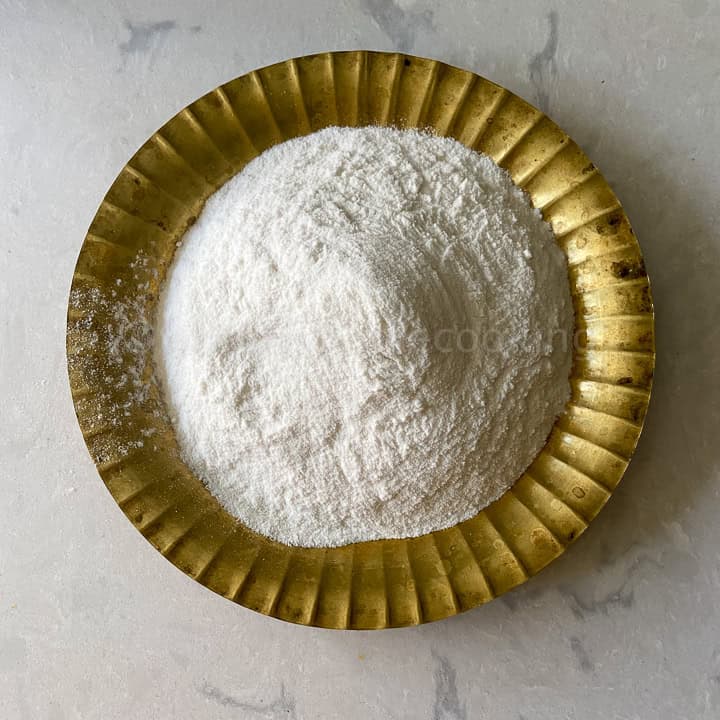
- Then add the powdered jaggery, cardamom powder, ghee (2 tbsp, unmelted), and edible camphor.
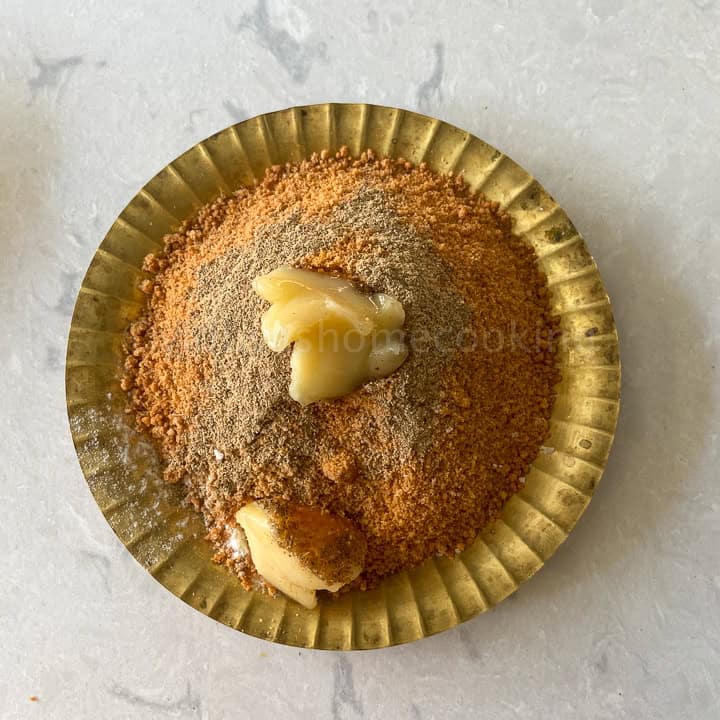
- Gently mix and press the flour mix tightly on the plate and form a small mound-like structure. At the top, make a small dent that will fit the cotton wick and ghee. Make sure the dent is deep so that the ghee doesn’t overflow.
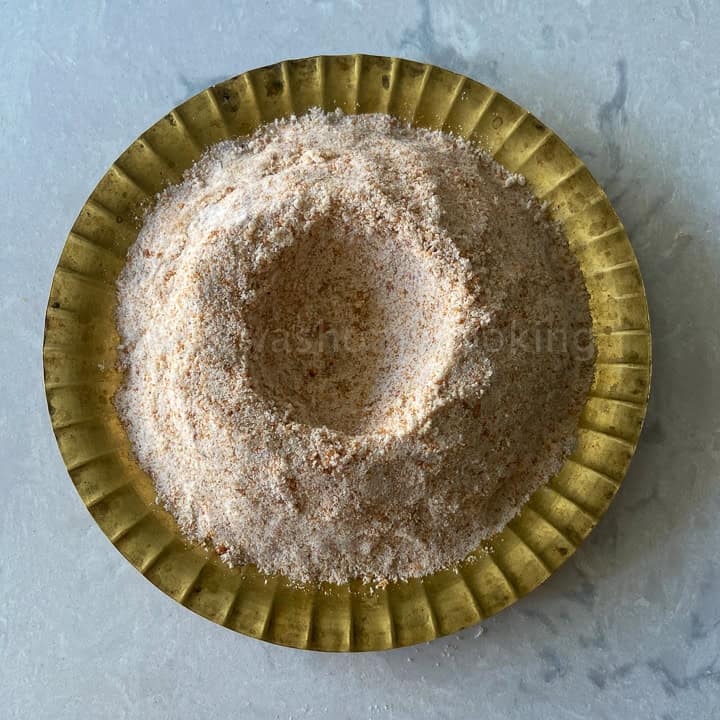
- I made my cotton-wick. But you can use the store-bought one. For the homemade one, take a small piece (marble-sized) cotton and flatten it. Take a small portion from the center, thin it, and form the wick like below.
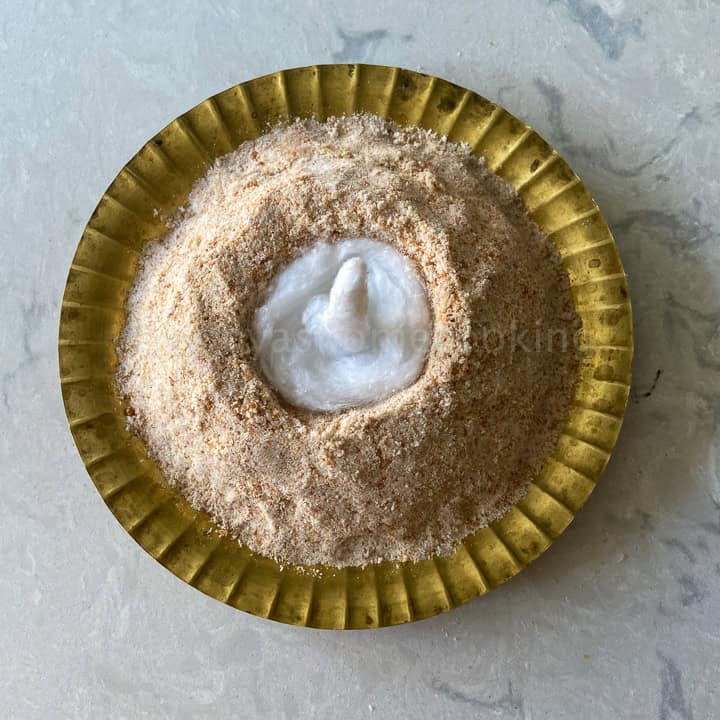
- The rice flour lamp is now ready.
The pooja procedure:
- I place this prepared rice flour lamp tray on a wooden board. Then place some coconut and fruits on either side. We also keep betel leaves; I skip them if I can’t source.
- Now I place this in the pooja room, add the ghee(1 to 1.5 tbsp, melted), and light the lamp. We also offer a sweet and savory dish as neivediyam.
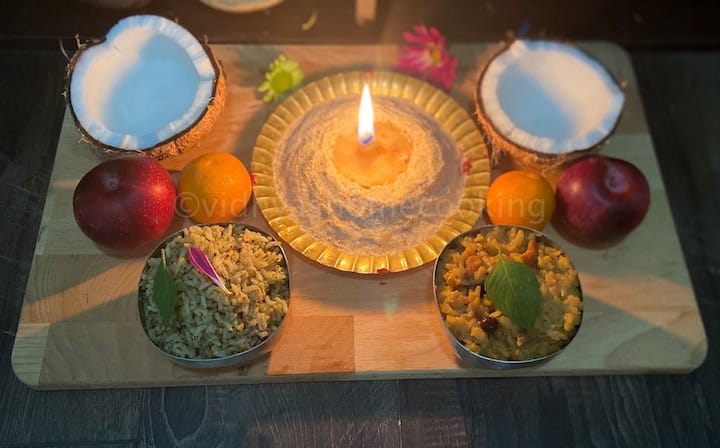
- When the ghee is almost exhausted or when the burning wick reaches the flour, remove the burning wick before it is extinct and place it on a plate-like below. Keep an eye on the lamp, and don’t let it overburn.
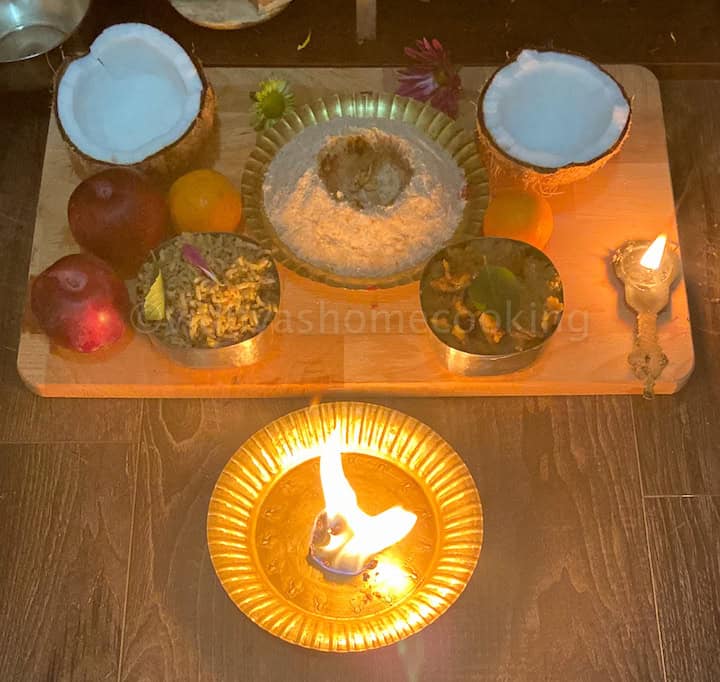
- Once the pooja complete, you can mix the rice flour mixture and add little milk, ghee, or water and make it into small laddus and enjoy.
Notes-
- As I mentioned before, every family have their way of preparing this lamp and the pooja procedure. I have shared what we follow.
- Adding edible camphor elevates the flavor of this rice flour mix, and if you can source and add them, please do try with edible camphor.
- Adjust the amount of ghee as required.
- Do not add water while preparing the lamp.
- Also, keep an eye on the lamp after you light it. Do not let it burn thoroughly.
PS – If you try this maa vilakku, please don’t forget to comment and rate this recipe. If you have any questions, please leave a comment, and I will get to it asap. Make sure to follow me on my Pinterest for more healthy and delicious ideas! Follow me on Instagram or join my Facebook Group for more gardening and recipe updates.
📖 Recipe
Maa Vilakku | Edible Rice Flour Lamp | Maa Vilakku Maavu
Ingredients
Measurement Details: 1 cup=240 ml; 1 tbsp=15ml; 1tsp=5ml;
- 1 cup rice flour store-bought
- 4/4 cup jaggery powdered
- 4 tbsp ghee divided (2 tbsp + 1 tbsp + 1 tbsp)
- 1 tsp cardamom powder
- ⅛ tsp edible camphor crushed
Instructions
Prepare the rice flour lamp-
- Take a clean plate in which you are going to light the rice flour lamp. Decorate the plate with kumkum and turmeric in a preferred way. Take the rice flour on the plate.
- Then add the powdered jaggery, cardamom powder, ghee (2 tbsp), and edible camphor.
- Gently mix and press the flour mix tightly on the plate and form a small mound-like structure. At the top, make a small dent that will fit the cotton wick and ghee. Make sure the dent is deep so that the ghee doesn’t overflow.
- I made my cotton-wick. But you can use the store-bought one. For the homemade one, take a small piece (marble-sized) cotton and flatten it. Take a small portion from the center, thin it, and form the wick like below.
- The rice flour lamp is now ready.
The pooja procedure:
- I place this prepared rice flour lamp tray on a wooden board. Then place some coconut and fruits on either side. We also keep betel leaves; I skip them if I can’t source.
- Now I place this in the pooja room, add the ghee(1 to 1.5 tbsp), and light the lamp. We also offer a sweet and savory dish as neivediyam.
- When the ghee is almost exhausted or when the burning wick reaches the flour, remove the burning wick before it is extinct and place it on a plate-like below. Keep an eye on the lamp, and don’t let it overburn.
- Once the pooja complete, you can mix the rice flour mixture and add little milk, ghee, or water and make it into small laddus and enjoy.
Notes
- As I mentioned before, every family have their way of preparing this lamp and the pooja procedure. I have shared what we follow.
- Adding edible camphor elevates the flavor of this rice flour mix, and if you can source and add them, please do try with edible camphor.
- Adjust the amount of ghee as required. If you don’t have powdered jaggery, you can also grind the rice flour and jaggery together and the flour will bind more easily in this case.
- Do not add water while preparing the lamp.
- Also, keep an eye on the lamp after you light it. Do not let it burn thoroughly.
Nutrition
I am not a nutritionist. The nutritional information is provided as a courtesy and is an estimate only. It varies depending upon the product types or brands.

Submitting this post for the Blogging Marathon #117. You can check out the participant details and their recipes at this link.


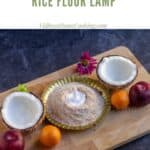
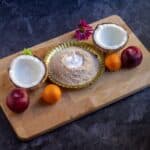

It is interesting to learn about different traditions across regions. I don’t make these lamps but back home, these are made for Mangala gowri vrata and some special occasions. We go with the lamps made with the thambittu. Your version sounds very unique to the region.
Yeah we call it as tambittu deepa but we started making it differently these days.
Very nice setup Vidhya. Good to read about the edible lamp.
Thanks Sushma.
The Picture set up is awesome Srividhya. Love this Maavilaku. I have made a couple of times when I was in India during the Tamil Lunar month of Puratasi. You have made with jaggery and its very healthy. Would definitely give a try.
Thanks a lot Radha.
Very interesting to read through different cultures and traditions that help us get closer to our roots…
Thanks Rafeeda.
A very divine setup there, Srividya. Very interesting to know about the different cultures. We make it differently but I rarely do it. I must ask my MIL on what occasions this lamp is lighted in our family. I don’t ever remember my mom doing it. Need to check on this.
Thanks a lot Harini. We usually do it during Navratri and during this Purattasi month.
Very interesting to read about the edible lamp . We all have different traditions and it is always best to share your family them , else they start dying .
The lamp looks very well made , in fact the whole set up looks divine .
Thanks a lot, Vaishali.